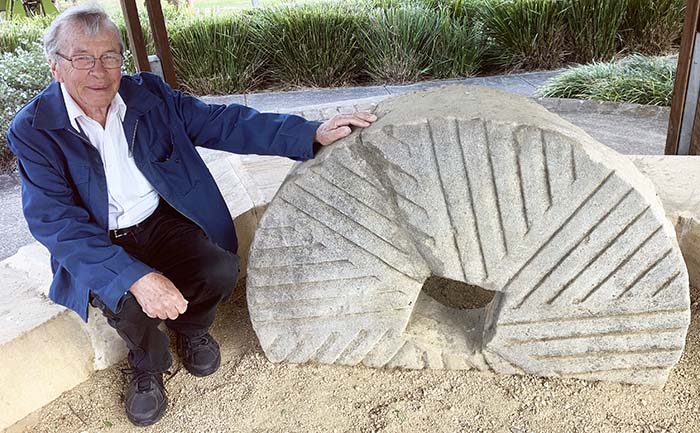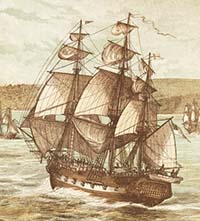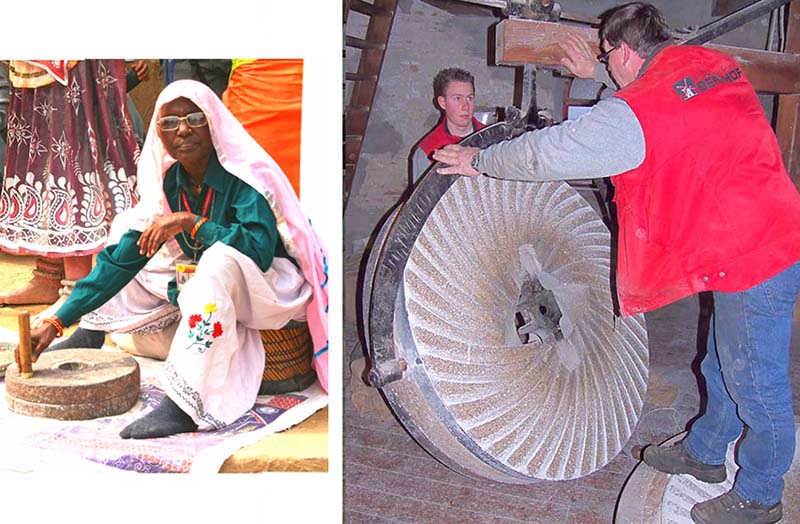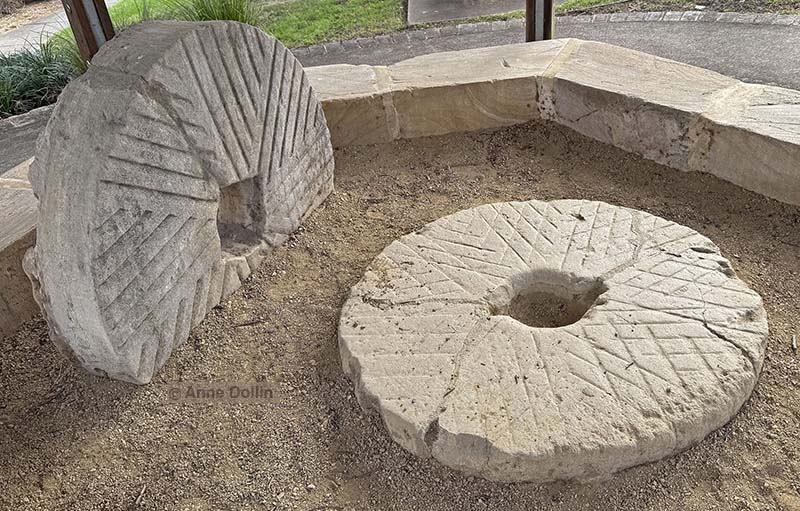
Millstones Used in Early Sydney Mills
1788 to 1820s
Researched by Anne and Les Dollin
Singleton Mills homepage > The earliest flour mills of Sydney, NSW > The millstones used in Sydney's first flour mills
What millstones were available to the early millers of Sydney?
In the early years of the British colonisation of Australia, there was an acute shortage of flour in Sydney, New South Wales (NSW). With an initial population of 1400 settlers who needed to be fed, flour was in great demand.
The settlers initially used iron or steel hand-mills to grind their wheat rations. However, these little mills quickly wore out. Sydney needed to build large-scale windmills or watermills to supply the population with flour.
Large-scale, powered, flour mills used pairs of huge millstones to grind the wheat. Each stone was about 1m to 1.5m in diameter, and, when new, it weighed over one tonne.

Above, Les Dollin with one of the massive old millstones from the Singleton Family flour mills at Kurrajong, NSW. (This stone is partially embedded in a bed of gravel for display.)
Many millstones were going to be needed to equip Sydney's flour mills!
Could millstones be cut from Sydney sandstone?
The Colony of Sydney was established in the Sydney Basin, where the dominant stone type is sandstone. Unfortunately, Sydney's local sandstone is unsuitable for making millstones.
In Britain, several types of sandstone had been successfully used for making millstones, such as Millstone Grit, Old Red Sandstone, and Greensand. However, generally in these sandstones, the sand grains are bound together strongly with a hard, high-silica cement.
In contrast, Sydney's sandstone is mostly bound together with a soft clay cement.[1] The myriad tiny sand grains in Sydney's sandstone can be scraped, fairly easily, from the stone surface.
Unfortunately, wheat is a particularly hard type of grain, and it takes a great deal of force to break open the grains and release the starchy flour inside. If Sydney's sandstone were used to make millstones, the stones would have produced a very gritty flour, that damaged the teeth of the consumers.
So, quarrying millstones from Sydney's local sandstone was not an acceptable option.
Early imports of millstones to Sydney
Imports of millstones into Sydney were rare in the first decade, since so few ships arrived with cargos from overseas. Although other shipments may have occurred, the only records we have found so far, of millstones coming to NSW during this period, are as follows:
(a) Four millstones on the First Fleet, 1788
– Two millstones were amongst the items to be dispatched to Botany Bay with the First Fleet, according to the account books of the Admiralty recorded in May 1787.[2]
– Four millstones were landed at Sydney Cove on 22 February 1788 from the Scarborough, after the First Fleet arrived in Australia.[3]
 |
Did these four millstones come from Britain or Cape Town? Read more about the millstones carried on the First Fleet: |
(b) Four pairs of small hand-mills (querns) on the Gorgon, 1791
– Four pairs of hand-operated mills, or querns, were brought to Sydney from Cape Town by Lieutenant Governor King on the Gorgon in 1791.[4]
(c) A proposal in 1792 to send four pairs of millstones
– A schedule prepared by the British Home Secretary, Henry Dundas, in January 1792 stated that four pairs of millstones and the equipment for two windmills were to be sent to NSW, following requests by Governor Phillip.[5] It is not known whether this shipment actually occurred.
(d) 'Grindstones' (probably querns) on the Shah Hormuzear, 1793
– 20 pairs of 'grindstones' A were purchased from the ship, Shah Hormuzear, when it arrived in Sydney Cove from Calcutta in April 1793.[6]
(e) Two pairs of millstones on the William, 1794
– A list of flour mill equipment that was shipped on the William was prepared by Home Secretary Henry Dundas in 1793. It included bolting reels, damsels, spindles, and two pairs of millstones.[7]
– Two pairs of millstones arrived in Sydney on the William, along with the other milling materials, in March 1794.[8]
A. Grindstones. This term may be used to describe the pairs of millstones used to produce flour. However, it may also be used to describe individual abrasive stones used to sharpen steel tools. Given that the description of the Shah Hormuzear cargo was '20 pair of grindstones', it is likely that these were pairs of small Quern Stones designed for grinding flour by hand.
Two of the shipments to Sydney, listed above, were of small hand-operated Querns, while the other three shipments were of larger, full-sized millstones used in a mechanised flour mill. These these photographs show the differences between these kinds of millstones:

Above left, a woman in India holds the handle of a pair of small quern stones used for grinding grain by hand. Above right, a man positions a full-sized millstone in a large-scale flour mill, whilst standing on the second millstone of the pair. Both images are from Wikimedia Commons: left, by Ramesh Lalwani; right, by Rasbak.
In spite of these shipments, millstones remained scarce in Sydney. In a 1796 letter that Governor John Hunter wrote to the Duke of Portland, he acknowledged Britain's concerns about the increasing costs of the Colony, but said,
'We shall, I fear, want some millstones and other articles for dressing flour.' [9]
Limestone millstones from Norfolk Island
The millstone shortage in Sydney was eased for a few years by some Calcarenite Limestone millstones that were imported from Norfolk Island.
An outpost penal settlement had been established on Norfolk Island by the British colonists within six weeks of their arrival in Sydney in 1788. In 1791, settlers on Norfolk Island had discovered large deposits of Calcarenite Limestone there, and they successfully produced millstones for the First Settlement on Norfolk Island from this limestone.
In 1805, the millwright, Nathaniel Lucas, brought several pairs of Norfolk Island millstones to Sydney, and these were pronounced to be 'superior in point of durability to any that can be procured here' [i.e. in Sydney].[10]
Norfolk Island millstones were used in Sydney flour mills for some years, and it is possible that further dispatches of these Calcarenite Limestone millstones may have been brought to Sydney before the Norfolk Island colony was abandoned in 1814.
Read about the extremely rare Calcarenite Limestone Millstones that we identified at Kurrajong, NSW  |
The arrival of French Burr Stones in Sydney
French Burr Stones were very hard and expensive millstones, made from a chert stone quarried in France. They were highly regarded by millers in many countries, for their ability to grind a fine white flour which was much in demand.

Above, a French Burr Millstone, proudly displayed by M. Joseph Markey at the Steenmeulen windmill in France in 2012. Photograph by Les Dollin.
The earliest record, that we have found, indicating that imported French Burr Stones had been brought to Australia was in 1808. William Bligh complained that three pairs of French Burr Millstones had been taken from the Government Stores by Macarthur, Blaxcell, and Kable for their own mills. He avowed:
'The Colony has suffered greatly by the disposal of these Stones, as they were intended to have been sent by You [Viscount Castlereagh] to the Infant Settlements in order to grind their Grain, and which they are much in want of.' [11]
The first newspaper advertisement, that we have found, listing French Burr Stones for sale in Sydney, was eight years later, in 1816:
'To be sold, a very excellent Pair of French Burr Stones, with Iron Spindle, etc., complete…' [12]
However, by the 1820s, advertisements for French Burr Stones became reasonably common in Australian newspapers. For instance, an 1827 advertisement in a Hobart newspaper stated:
'Mill stones.—On Sale, at the Stores of W.A. Bethune,—Seven Pairs of real French Bhurrs.' [13]
| A close up look at Australia's French Burr Stones ... and a hunt for their 30 million year old fossils! |
The spread of French Burr Stones in Australia
During the following years, more and more flour mills across Australia were equipped with these desirable, though costly, imported French Burr Stones, so that the fine white flour, so popular with customers, could be produced.
For example, at least four of the early watermills that were established by the Singleton Family had French Burr Stones:
– At Kurrajong, the Upper Mill had 'a pair of excellent French burr stones' by 1824,[14] and the Lower Mill had 'a pair of four feet six inch French burr stones as good as any in the Colony' by 1842,[15] and
– At Wisemans Ferry, the watermills at Dillons Creek and at Laybury Creek each had two pairs of French Burr Stones by 1841.[16]
The use of millstones in Australian flour mills continued until the 1880s when a new technology was introduced: steam-driven roller mills, fitted with sets porcelain or steel rollers, began to be imported into Australia from Europe.
Initially Australian millers often used roller mills alongside their older millstones. However, inevitably roller mills took over, except where specialist stone-ground flour was required for the health food market.[17]
COLONIAL MILLSTONES In desperate need of millstones from the 1820s to the 1840s, settlers in Tasmania, Victoria, South Australia, and Western Australia tried to quarry them locally. |
REFERENCES
Abbreviations:
HRA – Historical Records of Australia. https://nla.gov.au/nla.obj-442186184
HRNSW – Historical Records of New South Wales. https://nla.gov.au/nla.obj-343230396
1. Pells, PJN (2004) Substance and mass properties for the design of engineering structures in the Hawkesbury sandstone. Australian Geomechanics, 39(3): 1-21.
2. HRNSW, 10 May 1787, Vol 2, page 388 (image 424).
3. HRNSW, Vol 2, page 403 (image 439).
4. Selfe, Norman (1900) Annual address. Delivered to the Engineering Section of the Royal Society of New South Wales. Journal and Proceedings of the Royal Society of New South Wales. 34: i-xxix. Archived at Biodiversity Heritage Library.
5. HRA, 10 January 1792, Series 1, Vol 1, page 333 (image 365).
6. HRA, 19 April 1793, Series 1, Vol 1, page 421 (image 453).
7. HRNSW, 30 June 1793, Vol 2, page 53 (image 85).
8. Collins, David (1798) An account of the English Colony of NSW. Volume 1. London.
9. HRA, 20 September 1796, Series 1, Vol 1, page 665 (image 697).
10. The Sydney and New South Wales Advertiser, 17 March 1805.
11. HRA, April 1808 Series 1, Vol 6, page 605.
12. The Sydney Gazette and New South Wales Advertiser, 2 March 1816.
13. Colonial Times and Tasmanian Advertiser, 19 January 1827.
14. The Sydney Gazette and New South Wales Advertiser, 10 June 1824.
15. The Sydney Herald, 26 February 1842.
16. Australasian Chronicle, 31 August 1841.
17. Jack RI (1983) Flour mills. In: Industrial Archaeology in Australia, Birmingham J, Jack I and Jeans D (eds). Heinemann Publishers Australia.
Read More About Sydney's Early Flour Milling History
•• Sydney's First Flour Mills •• Sydney's First Mill Builders •• Australia's Colonial Millstones ••
Read More About Millstones
•• All about millstones •• French Burr Stones •• Basalt-like Cullin Stones •• Millstone Grit •• Old Red Sandstone, Puddingstone, and Lodswoth Stone •• Granite •• Limestone •• Artificial Millstones •• Norfolk Island Millstones •• Colonial Millstones ••